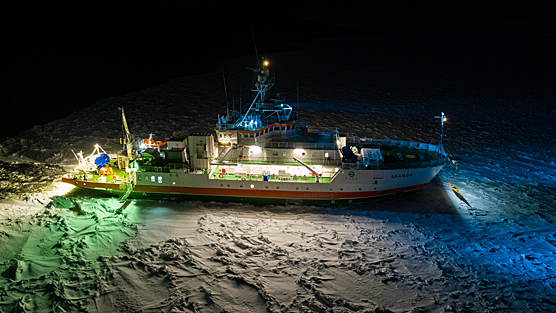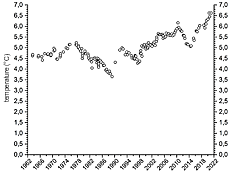Press release 2021-03-04 at 10:00
Press release of the Finnish Environment Institute SYKE and the Finnish Meteorological Institute

Research vessel Aranda on its monitoring cruise in January 2021 in the Bothnian Bay. Getting prepared for coring of an ice buoy of the Finnish Meteorological Institute. Photo: Ilkka Lastumäki, SYKE.
Water temperatures in the Baltic Sea are increasing and the deep-water temperatures are record-high in some areas. Phosphorus concentrations are rising in the central part of the Archipelago Sea and the Bothnian Sea. The observations were made during the annual winter monitoring cruise in January which is part of the Monitoring Programme of the Finnish Marine Management Plan.
An increase of 2-3°C in the deep-water temperature has been observed in the Baltic Sea. Record-high temperatures were measured in the Gulf of Finland, the Åland Sea, and the Gulf of Bothnia. In the Åland Sea Basin, which goes down to 285 metres (station F64), the recorded water temperature at 250 metres exceeded +7°C for the first time in the 57 years’ history of measurements.
“The high water-temperatures are probably related to the exceptionally warm winter of 2019-2020, movements of water masses in the Baltic Sea, and the effects of the climate change”, says Senior Scientist Pekka Alenius of the Finnish Meteorological Institute.

The temperature development at a depth of 100 metres at the monitoring station in the Northern Baltic Proper (LL17) in 1963–2021. Temperatures have been increasing since the 1990s. The latest five measurement results from Aranda’s monitoring cruises over a 1.5-year period are the highest in the monitoring history. Source: Finnish Meteorological Institute, Finnish Environment Institute SYKE
(Click to see a larger picture, png). High phosphorus concentrations in the
Archipelago Sea and the Bothnian Sea
Nutrient concentrations were high in the Kihti open sea area of the Archipelago Sea. The entire water column was evenly mixed down to the bottom and the oxygen situation was good. The high nutrient concentrations were mainly attributable to the mixing and inflow from the Northern Baltic Proper and the Gulf of Finland. The situation is also likely to be affected by the nutrient-rich water flowing from the inner Archipelago Sea.
“Phosphorus concentrations in the Bothnian Sea were high, as they have been in recent years and the change appears to be permanent. The oxygen situation in the deeps of the sea area has further deteriorated compared to previous years. The blue-green algal blooms that have become increasingly frequent in the Bothnian Sea are related to the increase in phosphorus concentrations”, says cruise leader Pekka Kotilainen of SYKE.
The oxygen situation in the Gulf of Finland deteriorated since last winter, surface phosphorus concentrations slightly decreased
The oxygen situation in the Gulf of Finland has deteriorated from the previous winter, when the oxygen situation of the near-bottom water was exceptionally good due to effective mixing. Now the deeps of the western Gulf of Finland were anoxic. There was also considerably less oxygen in the deepest parts of the central and eastern Gulf of Finland than a year ago. These situations with mixed and stratified water in the Gulf of Finland vary from year to year, depending on weather conditions.
“Phosphorus concentrations in the surface layers of the Gulf of Finland are still high, although during the last four years, the concentrations have slightly decreased in some areas. In the near-bottom water of the Gulf of Finland phosphorus concentrations were clearly higher than in the previous winter, and at one of the western stations of the Gulf of Finland the highest wintertime concentrations, since 1990, were observed”, says cruise leader Harri Kankaanpää of SYKE.
In the Gulf of Finland, near the Finnish coast, the nitrogen concentrations were higher than usual. This is affected by the nitrogenous river waters that have spread to the surface layer of the sea.
The deeps of the main basin of the Baltic Sea are still largely anoxic, and phosphorus concentrations in the deep-water have further increased.
SYKE and the Finnish Meteorological Institute jointly monitor the state of the open sea
During the monitoring cruise of the research vessel Aranda 18-31 January 2021, water and sediment sampling was carried out in order to monitor temperature, salinity, oxygen and nutrients, as well as the harmful chemicals such as pharmaceuticals. The sea areas that were studied included the Gulf of Finland, the Archipelago Sea, the Northern Baltic Proper, and the Gulf of Bothnia. In addition, the coverage and characteristics of the ice sheet in the Bothnian Bay were studied, and the monitoring of underwater noise was started at three off-shore stations in the Gulf of Finland, the Northern Baltic Proper and the Bothnian Bay.
SYKE and the Finnish Meteorological Institute are monitoring the state of the open seas in cooperation. SYKE is responsible for the monitoring of chemical and biological parameters and underwater noise, and the Finnish Meteorological Institute focuses on physical monitoring. Observations made by the Swedish Meteorological and Hydrological Institute (SMHI) were in the central and southern parts of the Baltic Sea in January were also included in this press release.
Inquiries
State of the Gulf of Finland, harmful chemicals, underwater noise:
Senior Researcher, cruise leader Harri Kankaanpää, Finnish Environment Institute SYKE, tel. +358 295 251 258, firstname.lastname@syke.fi
State of the Gulf of Bothnia, the Archipelago Sea, and the Northern Baltic Proper:
Senior Researcher, cruise leader Pekka Kotilainen, Finnish Environment Institute SYKE, tel. +358 295 251 317, firstname.lastname@syke.fi
Internal nutrient flows in the Baltic Sea:
Senior Scientist Jouni Lehtoranta, Finnish Environment Institute SYKE, tel. +358 295 251 363, firstname.lastname@syke.fi
Physical changes in the Baltic Sea, climate change:
Senior Scientist Pekka Alenius, Finnish Meteorological Institute, tel. +358 295 396 439, firstname.lastname@fmi.fi
Images
- Only for the media: Aranda in the Baltic Sea in January 2021. Photo: Ilkka Lastumäki, SYKE. (jpg, 9 Mt).
-
Temperature development at the depth of 100 metres at a monitoring station in the Northern Baltic Sea (LL17) in 1963-2021 (png).
-
Wintertime water temperature near the bottom of the Baltic Sea in 2019, 2020, and 2021. Source: SYKE, Finnish Meteorological Institute, SMHI (png).
-
Wintertime salinity of water near the bottom of the Baltic Sea in 2019, 2020, and 2021. Source: SYKE, Finnish Meteorological Institute, SMHI (png).
-
Wintertime oxygen content of water near the bottom of the Baltic Sea in 2019, 2020, and 2021. Source: SYKE, Finnish Meteorological Institute, SMHI (png).
-
Wintertime phosphorus content of the surface layer of the Baltic Sea in 2019, 2020, and 2021. Source: SYKE, Finnish Meteorological Institute, SMHI (png).